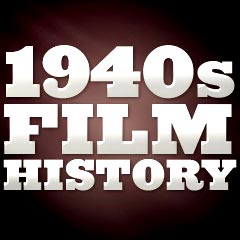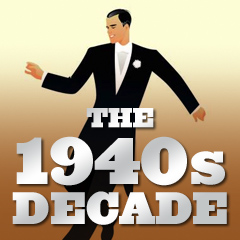 |
The 1940s The War and Post-War Years The Beginnings of Film Noir Part 1 Film History of the 1940s Part 1, Part 2, Part 3, Part 4, Part 5, Part 6 Film History by Decade Index | Pre-1920s | 1920s | 1930s | 1940s | 1950s | 1960s 1970s | 1980s | 1990s | 2000s | 2010s |

|
|
Hollywood During the War Years: The early years of the 40s decade were not promising for the American film industry, especially following the late 1941 attack on Pearl Harbor by the Japanese, and the resultant loss of foreign markets. However, Hollywood film production rebounded and reached its profitable peak of efficiency during the years 1943 to 1946 - a full decade and more after the rise of sound film production, now that the technical challenges of the early 30s sound era were far behind. Advances in film technology (sound recording, lighting, special effects, cinematography and use of color) meant that films were more watchable and 'modern'. Following the end of the war, Hollywood's most profitable year in the decade was 1946, with all-time highs recorded for theatre attendance. The world was headed toward rearmament and warfare in the early to mid-1940s, and the movie industry, like every other aspect of life, responded to the national war effort by making movies, producing many war-time favorites, and having stars (and film industry employees) enlist or report for duty. The US government's Office of War Information (OWI), formed in 1942, served as an important propaganda agency during World War II, and coordinated its efforts with the film industry to record and photograph the nation's war-time activities. Tinseltown aided in the defensive mobilization, whether as combatants, propagandists, documentary, newsreel or short film-makers, educators, fund-raisers for relief funds or war bonds, entertainers, or morale-boosters. Films took on a more realistic rather than escapist tone, as they had done during the Depression years of the 30s.
The Quintessential 40s Film: Casablanca War-Related Films Abound: The 40s also offered escapist entertainment, reassurance, and patriotic themes, such as William Wyler's war-time film Mrs. Miniver (1942), starring Walter Pidgeon and Oscar-winning courageous heroine Greer Garson as husband and wife. It was a moving tribute and account of courageous war-besieged Britishers reliving the trauma of Dunkirk and coping with the war's dangers in a village. Alfred Hitchcock, who had recently migrated to the US, directed Foreign Correspondent (1940), ending it with a plea to the US to recognize the Nazi menace in Europe and end its isolationist stance. William Wellman's The Story of G.I. Joe (1945) - immortalized WWII Pulitzer Prize-winning combat correspondent Ernie Pyle (Burgess Meredith) and his experiences with the men of Company C of the 18th Infantry and their role in the invasion of Italy, John Ford's They Were Expendable (1945) with star John Wayne in a story about the Pacific Ocean's PT boats, Delmer Daves' Destination Tokyo (1943), Zoltan Korda's exciting epic Sahara (1943) (with Humphrey Bogart as heroic desert tank driver Sgt. Gunn), and Lewis Milestone's intense, unglamorous war films of struggle, resistance, and occupation: Edge of Darkness (1943), The North Star (1943), The Purple Heart (1944) and the excellent A Walk in the Sun (1945). British director Michael Powell and Oscar-winning scriptwriter Emeric Pressburger joined forces for the war drama 49th Parallel (1941), the war adventure One of Our Aircraft is Missing (1941), and the superb character study classic The Life and Death of Colonel Blimp (1943). The Royal Navy (and Lord Mountbatten) was paid tribute in writer/co-director and star Noel Coward's WW II drama In Which We Serve (1942), co-directed with David Lean in his first directorial effort. It was the most celebrated and patriotic British war film of the era. Director Carol Reed's pseudo-war documentary The Way Ahead (1944) followed the training of soldiers to fight against Rommel's Afrika Korps.
After the war, William Wyler directed a provocative, dramatic Best Picture-winning film about the plight of three returning G.I. veterans (Dana Andrews, Fredric March, and Harold Russell) to the homefront. The multi-Oscar winning picture The Best Years of Our Lives (1946) was produced by Samuel Goldwyn and photographed by Gregg Toland. Non-professional, disabled veteran Harold Russell won a Best Supporting Actor Oscar for his role in the film. In two of the film's memorable scenes, Hoagy Carmichael taught double-amputee Russell to play Chopsticks on the piano, and Russell displayed his vulnerabilities to his fiancee (Cathy O'Donnell). Lightening up the wartime mood was Cary Grant who portrayed Captain Henri Rochard, a French soldier in Howard Hawks' gender-bending farcical comedy I Was a Male War Bride (1949), who was obliged to dress as a woman to marry an American female soldier (Ann Sheridan).
Part 1, Part 2, Part 3, Part 4, Part 5, Part 6 |